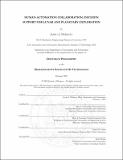| dc.contributor.advisor | Mary L. Cummings. | en_US |
| dc.contributor.author | Márquez, Jessica J., 1976- | en_US |
| dc.contributor.other | Massachusetts Institute of Technology. Dept. of Aeronautics and Astronautics. | en_US |
| dc.date.accessioned | 2007-08-29T19:06:15Z | |
| dc.date.available | 2007-08-29T19:06:15Z | |
| dc.date.copyright | 2006 | en_US |
| dc.date.issued | 2007 | en_US |
| dc.identifier.uri | http://hdl.handle.net/1721.1/38526 | |
| dc.description | Thesis (Ph. D.)--Massachusetts Institute of Technology, Dept. of Aeronautics and Astronautics, February 2007. | en_US |
| dc.description | This electronic version was submitted by the student author. The certified thesis is available in the Institute Archives and Special Collections. | en_US |
| dc.description | Includes bibliographical references (p. 219-224). | en_US |
| dc.description.abstract | Balancing task allocation between humans and computers is crucial to the development of effective decision support systems. This thesis investigates the appropriate balance between humans and automation for geospatial path problem solving within the high-risk domain of human planetary surface exploration, where decisions are time critical and humans must adapt to uncertainty. In order to develop flexible and robust decision support systems for Lunar and planetary exploration, human-automation role allocations are examined to understand how humans conduct complex optimizations under different degrees of automated assistance. A work domain analysis of human planetary extravehicular activities (EVA) resulted in a framework for human-robotic planning, including key input variables, constraints, and outputs. Based on this analysis, a prototype path planning aid was developed. Under investigation was the use of partial automatic path generation and a visualization called levels of equal cost (LOEC, an aggregate cost map). Human-in-the-loop testing was employed to understand the effects of the automated assistance and different visualizations on path planning performance across multivariate cost functions. In two separate experiments, participants were tasked to make obstacle-free, least-costly paths based on given cost functions. | en_US |
| dc.description.abstract | (cont.) Analysis of the experimental results indicated that knowledge-based reasoning is best supported when operators conduct manual sensitivity analysis, a strategy that was absent when path generation was allocated to automation. Leveraging computer-generated paths resulted in overall better path performance but also led to automation bias and decreased situation awareness. With respect to visualizations, participants using elevation contours had lower cost paths and short task times when automation was reliable. However, the LOEC visualization helped participants initially create least-costly paths for the most complex cost function. Furthermore, LOEC visualization appears to promote manual sensitivity analysis, which was beneficial in the degraded automation condition, where low cost and time was observed for participants with this visualization. Finally, two types of sensitivity analysis were observed, one that leveraged the available "what if" tools and the other that created whole paths. While there was no difference in path costs across the strategies, the increase use of the manual sensitivity analysis (i.e., path modifications) led to decrease path cost errors. Supported by: NASA Harriett Jenkins Predoctoral Fellowship, Office of Naval Research, National Space Biomedical Research Institute (NSBRI/NASA) and the American Associate of University Women Dissertation Fellowship. | en_US |
| dc.description.statementofresponsibility | by Jessica J. Márquez. | en_US |
| dc.format.extent | 225, [1] p. | en_US |
| dc.language.iso | eng | en_US |
| dc.publisher | Massachusetts Institute of Technology | en_US |
| dc.rights | M.I.T. theses are protected by copyright. They may be viewed from this source for any purpose, but reproduction or distribution in any format is prohibited without written permission. See provided URL for inquiries about permission. | en_US |
| dc.rights.uri | http://dspace.mit.edu/handle/1721.1/7582 | |
| dc.subject | Aeronautics and Astronautics. | en_US |
| dc.title | Human-automation collaboration : decision support for lunar and planetary exploration | en_US |
| dc.type | Thesis | en_US |
| dc.description.degree | Ph.D. | en_US |
| dc.contributor.department | Massachusetts Institute of Technology. Department of Aeronautics and Astronautics | |
| dc.identifier.oclc | 162623870 | en_US |
